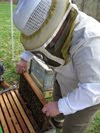
It's the first thing that most people think of when you say the word "bee". They think Stinger.
I hope that will change and instead people will learn more about bees. Think of their soft buzzing, how much they care for their babies and family and how they work together to make the sweetest thing on earth: Honey.
[This is a honey bee stinging a person. Photo from Wikipedia.com].
Attached to the stinger is a tiny sac filled with venom (the white part is the sac). The sac also has a muscle attached that pumps the venom and helps to drive the stinger deeper into the skin--even after it's been torn away from the bee this muscle keeps pumping for about 20 minutes.
When the stinger pierces the skin of a human or an animal, like a skunk, bear or raccoon, it sticks because it has little barbs on it that catch and hold on flesh. When the bee flies away, her stinger is torn away, along with the end of her abdomen, and often some of their insides too.

It's not very pleasant for the person being stung, or for the bee, who will die.
[This is a much magnified drawing of the bee's stinger. Can you see the venom sac attached?]
Wasps and hornets don't have barbs on their stingers so they can sting multiple times without dying.
Honey bees can sting other insects many times without dying because the stinger's barbs won't stick in insect flesh because it's so pulpy.
Okay, that's the scientific part. But the human part is, "OUCH! That hurt!"
What to do if you've been stung:
If you've been stung, look at the spot where your skin was pierced. Is there a tiny black stinger in your skin? There might even be the venom sac attached. If it's there, immediately scrape it away. The longer the stinger sticks in your skin the more venom that little muscle will pump. The more venom you get, the more pain and swelling you will have.
The sting may be painful at first and there is often redness and swelling and then it'll become itchy. The swelling and itchiness will last a few days. Try your best not to scratch or it will become more itchy. I have learned this and I do my best not to scratch stings. I find they don't swell so much and the itchiness goes away faster that way. Cold compresses put on right away are helpful to reduce swelling too.
Bee Attitude
Honey bees knows they will die if they sting someone. Because of that they don't want to sting unless they feel threatened or that it's necessary to protect their hive. When bees are away from their hive foraging they don't feel so protective. In fact, they're too busy collecting food to be bothered with people. Even when beekeepers open the hive, most of the time the bees will be gentle.
When my Dad and I work on our hives, we very rarely get stung. Most of the time if we do, it'll be our fault because we accidentally squished a bee with our finger, and she stings to say, "Hey, get off me!"
Honey bees only eat nectar and pollen. If you're having a picnic or are eating a candy apple and a "bee" is bothering you, take a closer look. It won't be a bee. It'll be a wasp, most likely a yellow jacket. Wasps and hornets are omnivorous - that means they eat everything: Sugar, Meat, Nectar, etc., and yellow jackets really love tuna fish sandwiches and orange pop.
We all say "stung by a bee" but 99% of the time when people are stung it's by that yellow jacket when we're enjoying food outside.
Bees don't bite, so the term "bitten by a bee" or "bitten by a wasp" isn't true. Their mouth parts aren't big or strong enough to do much biting. When these stinging insects are going about their business flying around, their stingers are retracted inside their bodies.
Stung on Purpose? Are you Crazy?
Some people use a technique where they make honey bees sting them on certain spots on their body--on purpose. It's considered as a treatment for an illness or for pain. It's called Apitherapy. I have noticed that after I got stung on my arm, that the stiffness that I usually have in my hands every day went away for over a week. Dad noticed the arthritis in his hands was gone after he got stung. Opinions vary about this so if you're interested to know more you can do some research on the Internet.
 Pollen comes in many colours such as: White, yellow, red, orange, blue, purple, green and even black .
Pollen comes in many colours such as: White, yellow, red, orange, blue, purple, green and even black . Some flowers such as poppies and tulips can have black pollen. I'm sure the black pollen tastes just as nice as the red or yellow.
Some flowers such as poppies and tulips can have black pollen. I'm sure the black pollen tastes just as nice as the red or yellow. Pollen is part of the life force of a plant and its needed for a plant to produce its babies...seeds. Those seeds will make new flowers.
Pollen is part of the life force of a plant and its needed for a plant to produce its babies...seeds. Those seeds will make new flowers. But the flowers know someone who can carry their pollen from one flower to the next. Can use guess who that someone is? Yes, it's the bees.
But the flowers know someone who can carry their pollen from one flower to the next. Can use guess who that someone is? Yes, it's the bees. The bee will use her legs to scrape some of that pollen up. Then she'll add some of her spit and honey to it to moisten it. Then she'll stick it to her back leg where there's really stiff hairs that will hold it in place.
The bee will use her legs to scrape some of that pollen up. Then she'll add some of her spit and honey to it to moisten it. Then she'll stick it to her back leg where there's really stiff hairs that will hold it in place. Pollen is very important to bees because it's full of protein. Baby bee larvae need to eat pollen so they'll grow healthy and strong. Just like how you and I need protein too so we'll grow.
Pollen is very important to bees because it's full of protein. Baby bee larvae need to eat pollen so they'll grow healthy and strong. Just like how you and I need protein too so we'll grow. This is a tray of pollen that a beekeeper has collected. You can see that it's mostly a green colour. The beekeeper will put this pollen in a jar to sell to people. (In another story I'll tell you how the beekeeper collects pollen from the bees).
This is a tray of pollen that a beekeeper has collected. You can see that it's mostly a green colour. The beekeeper will put this pollen in a jar to sell to people. (In another story I'll tell you how the beekeeper collects pollen from the bees).













 No matter the colour, bees' blood is just as important to the function of their healthy body as our blood is to us.
No matter the colour, bees' blood is just as important to the function of their healthy body as our blood is to us.

 Yuck! What are these?
Yuck! What are these?


























